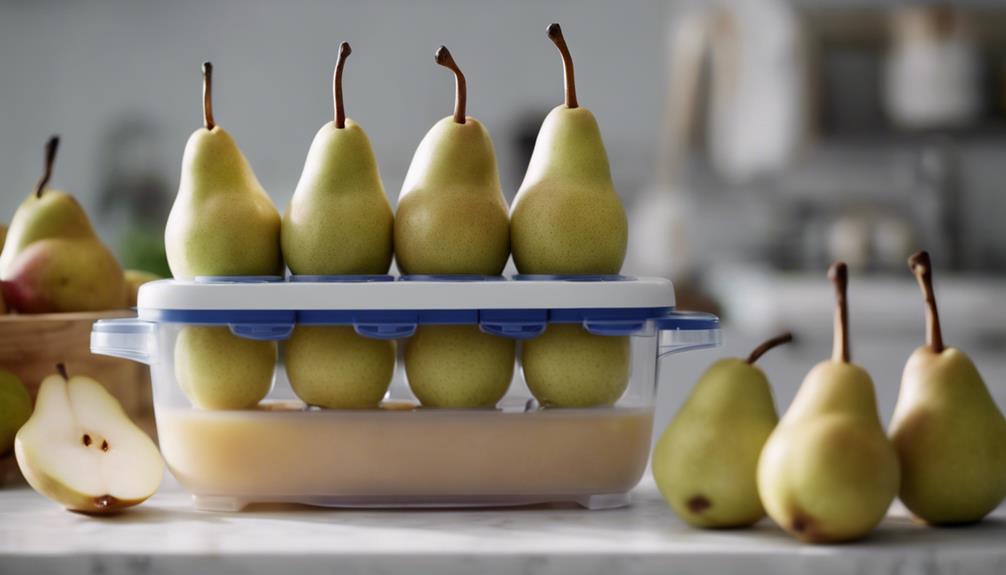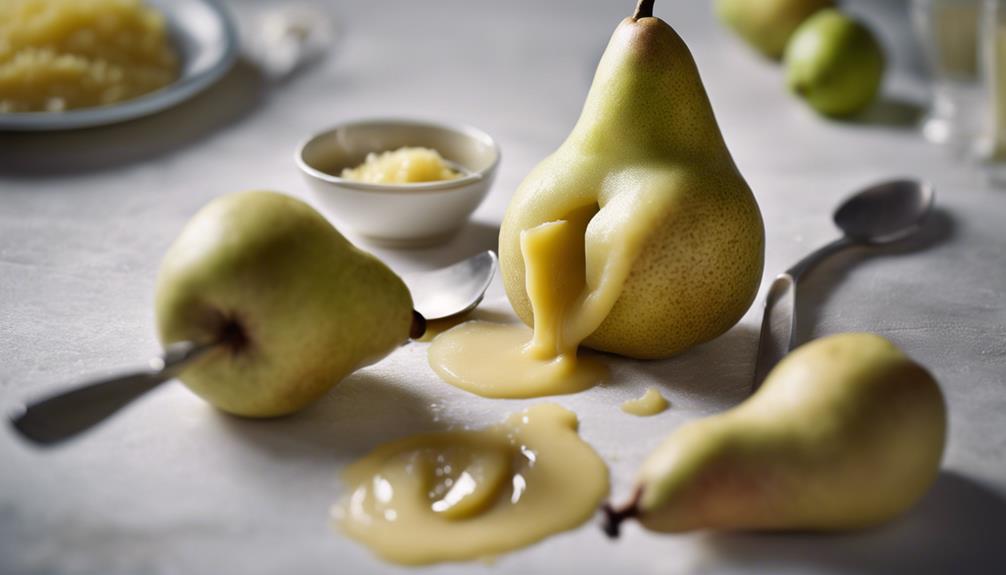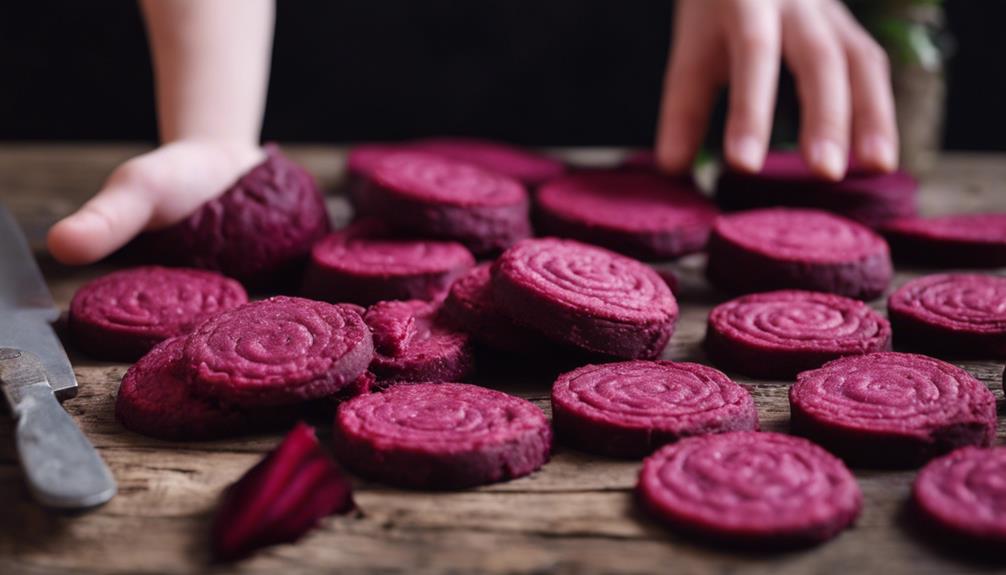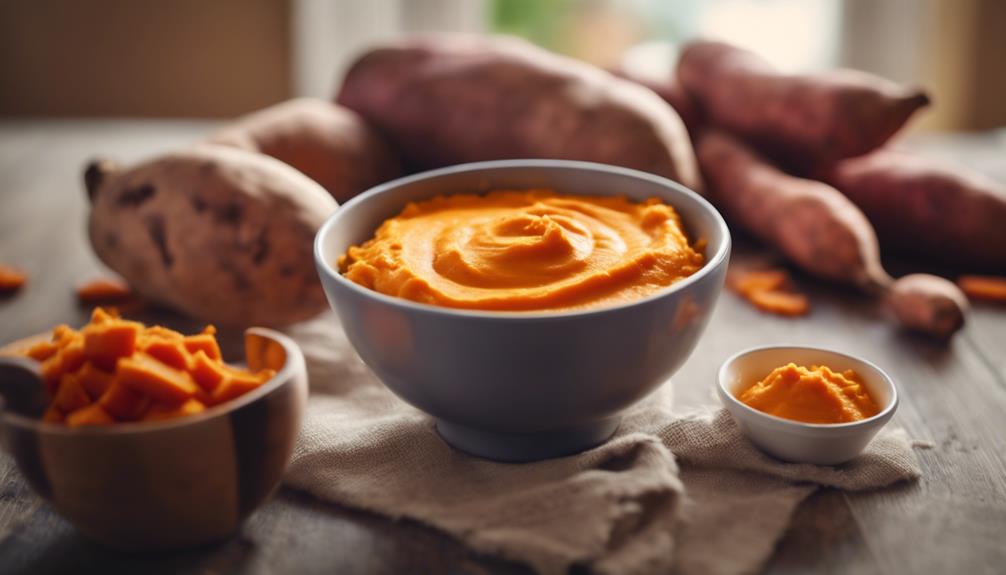To make pear puree for your little one, choose ripe Bartlett pears for a sweet, smooth flavor. Peel, chop, and blend the pears to create a healthy baby food treat. Remember to freeze the puree in silicone ice trays for added convenience. Try different types of pears to add variety to your baby’s meals. For more information on enhancing flavors, storage tips, and the amazing benefits of pear puree, continue to explore the world of homemade baby food – it’s full of surprises!
Key Takeaways
- Use ripe Bartlett pears for sweet, smooth puree.
- Peel, chop, and blend pears for nutritious baby food.
- Freeze puree in silicone ice cube trays for convenience.
- Experiment with different pear types for varied flavors.
- Control ingredients by cooking and pureeing pears at home.
Pear Puree Recipe Basics
For a simple and nutritious baby food option, consider making pear puree using fresh, ripe Bartlett pears. Bartlett pears are recommended for their sweet taste and smooth texture, ideal for introducing your little one to their first fruits.
Start by peeling and chopping the pears before blending them into a smooth puree using a blender. This homemade baby food isn't only delicious but also packed with essential nutrients for your baby's development.
To make mealtime even more convenient, consider freezing the pear puree in silicone ice cube trays. This way, you can easily portion out servings and thaw them as needed.
Cooking and pureeing pears at home allows you to control the ingredients and provide a fresh and healthy meal for your baby. Experiment with different types of pears to introduce a variety of flavors to your little one's diet.
Enjoy the process of creating nutritious meals for your baby with this simple and versatile pear puree recipe.
Video and Tools

So, you're ready to whip up some delicious pear puree for your little one – great choice!
The video guide will walk you through the process step by step, making it super easy to follow along.
Plus, with the right tools like a blender and reusable pouches, you'll be all set for a smooth and successful puree-making adventure!
Tools for Pear Puree
Consider watching a video tutorial showcasing the essential tools needed for making pear puree at home.
To start, you'll need a quality blender to achieve that smooth consistency for your pear puree.
A steamer insert will come in handy for cooking the pears to perfection.
Don't forget about freezer trays for convenient storage and reusable pouches for serving that delicious puree to your little one.
For a comfortable feeding experience, a Tripp Trapp High Chair is a great addition to your setup.
And to keep things clean and easy during mealtime, silicone baby bibs are your best friend.
Lastly, make sure you have storage containers on hand to keep your pear puree fresh and ready for future meals.
Essential Equipment Suggestions
Explore a video tutorial demonstrating the essential tools required for preparing pear puree at home efficiently. To start, a good quality blender is key for achieving a smooth and creamy consistency when pureeing pears.
Additionally, using a steamer insert can help maintain the nutrients in the pears while cooking, making it a healthier option for your baby.
When it comes to portioning and storing the puree, freezer trays are a convenient choice, allowing you to freeze individual servings for future use.
For mess-free feeding, consider using silicone baby bibs to protect your little one's clothes during mealtime.
Finally, reusable pouches are great for storing and serving pear puree on the go, making it easy to feed your baby while out and about.
These tools not only make the process of preparing pear puree simpler but also ensure convenient portioning, storing, and serving, ultimately leading to a hassle-free and enjoyable feeding experience for both you and your baby.
Reusable Pouch Benefits
Discover the practical advantages of utilizing reusable pouches for storing and serving homemade pear puree while on the move. Reusable pouches aren't only eco-friendly but also help reduce waste when compared to single-use baby food pouches.
These pouches are easy to clean, and most of them are dishwasher-safe, making maintenance a breeze. By opting for reusable pouches, you can save money in the long run as they can be used multiple times.
The versatility of these pouches is unmatched, with various sizes and designs available to cater to different feeding needs. Whether you're out for a stroll or on a road trip, these pouches make it convenient to carry and serve your homemade pear puree hassle-free.
Ingredients and Instructions

Alright, let's get down to the nitty-gritty of making that delicious pear puree for your little one.
First up, you'll need some organic pears, water, and maybe a dash of cinnamon or ginger if you're feeling fancy.
The process involves peeling, cutting, steaming, blending, and portioning – but don't worry, it's easier than it sounds!
Recipe Ingredients
To prepare pear puree for your baby, gather pears, water, and any desired spices like cinnamon or ginger as the main ingredients. Pears provide natural sweetness, while water helps achieve the desired consistency. Spices like cinnamon or ginger can add a delightful twist to the flavor profile.
Begin by peeling and cutting the pears into small pieces for easier steaming. Steaming helps soften the pears, making them easier to blend into a smooth puree. Adjust the consistency by adding water gradually during the blending process until you reach the desired texture for your baby.
Don't overlook storage options; storing the pear puree in the fridge ensures freshness for a few days, or freeze it for longer shelf life.
Preparation Steps
Dice the ripe pears for easy blending and a smooth texture in the puree. Peel off the skin to guarantee a velvety finish.
Next, cook the diced fruits with a sprinkle of cinnamon or ginger to add a delightful touch of flavor to the baby food. Simmer the pears gently with water until they're tender and infused with spices.
Once cooked, transfer the mixture to a blender. Blend the pears until they reach a smooth consistency, adjusting the thickness by adding water if necessary.
Consider using a steamer insert or a slow cooker for gentle cooking that helps retain essential nutrients.
Finally, store the pear puree in a suitable container for easy access and freshness. Airtight containers or freezer trays work well for keeping the puree fresh and ready for your little one's next meal.
Enjoy the process of making nutritious and delicious baby food for your little foodie!
User Engagement and Comments

Engage with other users by sharing your experiences and tips on the pear puree recipe to build a vibrant community around baby food preparation. Leave comments to inspire interaction and foster a sense of camaraderie among fellow parents exploring the world of homemade baby food.
Your insights and variations can spark creativity and help others discover new ways to enhance the pear puree for their little ones. Don't hesitate to ask questions or offer suggestions; this platform is designed for you to connect with like-minded individuals on this exciting journey.
Preparation and Storage Tips

For peak freshness and convenience, consider steaming the pears and storing the pear puree in small airtight containers in the fridge for up to 5 days.
By cooking pears for your baby, you guarantee a smooth and nutritious meal. Adjust the thickness of the pear puree by adding water until it reaches the perfect consistency for your little one. Steaming the pears is a fantastic healthy cooking method that helps retain essential nutrients, making it an ideal choice for your baby's food.
To store the pear puree, opt for small airtight containers to keep it fresh and ready to serve. If you want to extend the storage time, freeze the pear puree in small portions using ice cube trays. This method allows for longer storage, up to 6 months, providing you with a convenient baby food option whenever you need it.
Benefits and Usage of Pear Puree

Pear puree offers a plethora of health benefits and versatile culinary uses, making it a valuable addition to your baby's diet and your kitchen repertoire. Here's why you should consider incorporating pear puree into your meals:
- Nutrient-Rich: Pear puree is packed with fiber, essential vitamins, and minerals that support digestion and heart health, making it an excellent choice for both you and your little one.
- Boosts Immune System: The vitamins and minerals in pear puree can help boost the immune system, keeping you and your family healthy all year round.
- Substitute for Oil: When baking, you can use pear puree as a substitute for oil, reducing the fat content of your recipes while adding a natural sweetness.
- Enhances Flavor: Pears are incredibly versatile and can be paired with various spices like cinnamon, nutmeg, ginger, or vanilla to create unique and delicious flavor combinations in your dishes. Try adding pear puree to smoothies, pancake batter, yogurt, oatmeal, sauces, or dressings to enhance the nutritional value and taste of your meals.
Enhancing Flavor and Recipe Ideas

Enhancing the taste of your dishes can be achieved by incorporating various spices and ingredients into pear puree, allowing for a diverse range of flavorful recipe ideas.
Spice up your pear puree with options like cinnamon, nutmeg, ginger, vanilla extract, or a squeeze of lemon juice.
Get creative and experiment with combinations like pear muffins, oatmeal cookies, smoothie bowls, yogurt parfait, or even pancakes using your delicious pear puree as a base.
Mix and match different fruits and vegetables to create unique flavor profiles that will surprise and delight your taste buds.
For a savory twist, try incorporating pear puree into sauces or dressings to add a hint of sweetness and depth to your dishes.
And for a touch of luxury, don't be afraid to add a bit of butter to your pear puree for a rich and creamy texture that will elevate your recipes to the next level.
Let your imagination run wild with these recipe ideas and enjoy the delightful flavors you can create with pear puree!
Extended Storage and Thawing Instructions

To guarantee the longevity of your pear puree and maintain its quality, proper storage and thawing procedures are crucial. Here are some simple tips to help you make the most out of your pear puree:
- Refrigerate: Store your pear puree in airtight containers in the refrigerator for up to 5 days to maintain freshness and flavor.
- Freeze: For longer storage, freeze your pear puree in ice cube trays. This method can keep your puree good for up to 6 months.
- Thaw: When ready to use frozen pear puree, thaw it in the refrigerator to preserve its texture and taste.
- Label and Date: Remember to label your containers with the date of preparation. This not only helps you keep track of the freshness but also aids in rotating your stored pear puree efficiently.
Frequently Asked Questions
Can I Puree Raw Pear for Baby?
You can puree raw pears for your baby, especially if they are over 8-10 months old. However, cooking pears for babies under 8-10 months can aid in digestion. Starting them on cooked and pureed pears at 6 months is recommended.
Do You Peel Pears Before Pureeing?
When pureeing pears for baby food, you should peel them first. This helps create a smoother texture, reducing choking hazards. For little ones under 8-10 months, peeled pears are easier to digest. Over that age, raw, peeled pears are fine.
How Do You Keep Pureed Pears From Turning Brown?
To keep pureed pears from turning brown, add lemon juice for acidity, store in an airtight container, cover with plastic wrap touching the surface, refrigerate promptly, and use antioxidant-rich fruits or vitamin C powder.
What Can I Mix With Pear Puree for Baby Constipation?
To relieve baby constipation, mix pear puree with high-fiber fruits like prunes or peaches. Add pureed veggies such as spinach or broccoli for extra fiber. Combine with whole grains like oatmeal or rice cereal for better digestion.
Conclusion
In just a few simple steps, you can create a delicious and nutritious pear puree that your little one will love.
With its smooth texture and sweet flavor, this baby food recipe is sure to be a hit at mealtime.
So grab your blender, ripe pears, and get ready to whip up a batch of homemade goodness that will have your baby smiling from ear to ear!
Enjoy the process and the tasty results!










